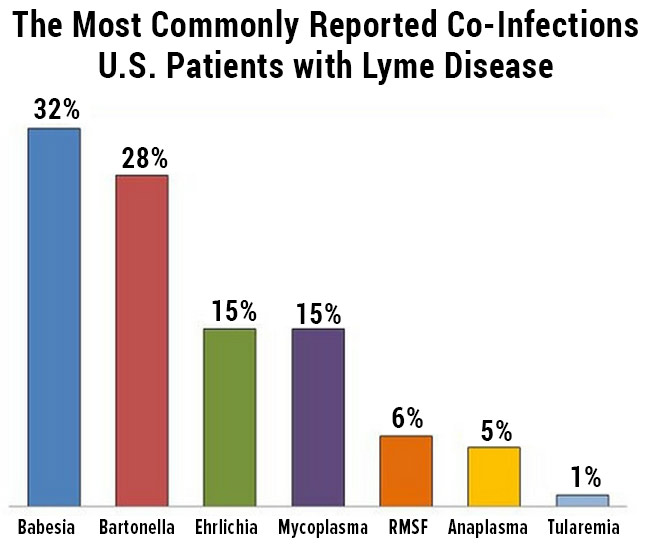Tick-Borne Co-Infections are the Rule, Not the Exception The recognition of tick-borne pathogens that are responsible for human illness is accelerating.
W hile Lyme disease is the fastest growing vector-borne disease in the United States, many other bacteria, parasites, and viruses can also be transmitted by ticks.
These are generally referred to as “co-infections” of Lyme, since people often have them at the same time as Lyme disease. While U.S. cases of Lyme disease are estimated to be over 300,000 per year, no one really knows the incidence of co-infections.
In a LymeDisease.org survey of over 3,000 patients with chronic Lyme disease, more than half reported laboratory-confirmed co-infections, with 30% having two or more. According to Dr. Richard Horowitz, “The existence of these co-infections explains why some people with Lyme remain chronically ill even after treatment.”
The most common co-infections reported with Lyme disease are Babesia (32%), Bartonella (28%), and rickettsial illnesses (26%). Rickettsial illnesses include ehrlichiosis (15%), Rocky Mountain spotted fever (6%), and anaplasmosis (5%).

Ticks Transmit 94% of Vector-Borne Diseases
Most vector-borne diseases (VBDs) in the United States are transmitted by ticks. Of the nearly 50,000 cases of VBDs reported to the Centers for Disease Control (CDC) in 2014, 94% were tick-borne, with most of those being Lyme disease. Only 6% of VBDs were from mosquitoes. Yet, Lyme receives only a fraction of the research funding given to Zika and West Nile virus.
The recognition of tick-borne pathogens that are responsible for human illness is accelerating.
Eleven new ones have been discovered since 1960, with over half of those found since 2000.
Several factors contribute to the increase of TBDs:
- improved diagnostics,
- climactic changes (warm wet weather),
- reforestation and population increases of mice/deer,
- range expansion and population increases of ticks,
- lack of a single, effective, widely accepted preventative strategy.





























My husband was just confirmed with Lyme disease. We have been 2yrs of doctors scratching their heads as to what was going on. What other test should be done at this point?
My husband has chronic lymes. Just got through with every heart test imaginable. Hearts perfect. But he was passing out/ fainting, we have no idea why. He has severe weakness and major weight gain. They did a thyroid test and nothing, so what else should we look for? I haven’t been able to find a doctor that has any background in lymes and I need a list of demands for tests. I had to demand the lymes test. Feeling very lost.
So sorry to hear Marlene, no one should have to go through that. If you have concerns about tick-borne disease, we suggest you consult with a Lyme-literate practitioner. Here is a link to our physician directory: https://www.lymedisease.org/find-lyme-literate-doctors/
Testosterone level dropped 400 points from 650 t0 250 along with the side effects including gout
lyme attacks the thyroid gland…the bacteria love to eat the gland, as it is a favorite food…go to the website STTM because most of the regular testing is poor/inadequate…the endo docs typically use the TSH test as the be-all end-all value…it is not…get the free T3 and free T4 and reverse T3 and the two thyroid antibody tests…or you won’t know what is happening the the thyroid gland.